A Love Letter to Lahmacun
From Bakırköy to Ümraniye, I explored some of my favorite Istanbul lahmacun joints. Here's an ode to one of this region's most beloved oven-baked delicacies:
Is there anyone in this country who doesn't love lahmacun? I doubt it. There is a reason why numerous places in Istanbul nowadays offer vegan and gluten-free versions. Everyone who has eaten lahmacun in the past craves it regardless of what diet they currently adhere to. Could lahmacun be Turkey's national dish? I won't get into that debate, as it is equally popular in other countries in the region (Armenia in particular) and the etymology of the word (which literally translates to 'dough with meat') is entirely Arabic. There is nothing to dislike about this baked delicacy: it is light but also filling, flavorful from the spiced, minced meat and healthy with the addition of sprigs of fresh parsley, sliced tomatoes and the mandatory squeeze of lemon juice before it is rolled up into a wrap and devoured while still crispy. It is the humble staple of working-class Eastern Anatolian migrants that eventually made its way onto the menus of some of the fanciest restaurants in Istanbul.
I've eaten numerous regional varieties from the source and at some of the excellent purveyors of the tradition in Istanbul. There is the Urfa variety, prepared with onion but no garlic, and its counterpart from Gaziantep, which includes garlic but omits onion. Diyarbakır-style lahmacun offers both. Who doesn't like garlic apart from vampires anyway? There's Tarsus fındıklı lahmacunu, which are small discs with the circumference of a beer can, where the dough is thicker and the meat is front and center. These are served in portions of a dozen or so alongside fiery, spicy pickled green peppers that are ubiquitous in the Çukurova region. My personal favorite encounter with lahmacun came surprisingly in Kozan, Adana, where it is also served by default in portions, larger than Tarsus-style but considerably smaller than standard lahmacun. The dough is on the pleasantly chewier side, not unlike Konya's etli ekmek, and liberal amounts of domates and biber salça are used, which gives it the edge. At Kebap 9 in Ankara, the lahmacun is massive, the size of a large pizza, spiced perfectly and baked to perfection and served alongside complementary appetizers including salad, acılı ezme, haydari and çiğ köfte.
I could continue to reminisce about the different types of excellent lahmacun we've enjoyed throughout Turkey, we've narrowed down the focus here to four top spots in Istanbul. It wasn't easy, as there are many contenders, but this selection includes locations from as far on the Anatolian side as Ümraniye to the Western European side as Bakırköy. But the first spot that came to mind is close to home, Mahir Lokantası in Osmanbey. Mahir Lokantası is one of the few restaurants that manages to pull off having a huge menu spanning different types of cuisine with everything being impeccable. There's numerous kebabs, stews and other home-cooked dishes that rotate daily and often run out before dinner time, and then there is the oven, where İsmail usta, a lahmacun veteran of 30 years, bakes up what I consider the best in the city. Ismail usta has worked together with the restaurant's namesake and owner Mahir Nazlıcan since it opened a decade ago.
I've been coming in ever since, and in its early years, Mahir Lokantası became quickly popular among white collar office workers in the area who would come in on their lunch break. But in the evening, things were slow, and Mahir once ruefully pondered about what to do to get more people in the door. He was fed up with the delivery apps and their high commissions. I suggested a meyhane concept, but that would have been another endeavor entirely and exhausting to pull off.
In 2019, I tweeted that for my money, Mahir Lokantası makes the best lahmacun in Istanbul. I've thought so ever since my first bite. The meat is a carefully-selected mix of beef and lamb cuts of the utmost quality, while the dough is perfectly configured, topped and sent into the oven by İsmail usta, who we reckon has probably made tens of thousands of lahmacun over the course of his career. It's crunchy, spicy, wholesome and sinfully savory all at once. The response to the tweet was mixed, many people hadn't heard of the restaurant and basically accused me of blasphemy. Amid the controversy, Vedat Milor chimed in and asked if I had tried the lahmacun at some of the city's iconic spots. I told him that I had, and still think Mahir is the best. Milor proceeded to visit the restaurant multiple times, lavishing praise on its lahmacun, which resulted in a surge of popularity. Nowadays, there's a perpetual line out the door, and Mahir isn't worried about the evenings. With food this good, this was bound to happen eventually. When asked about the secret behind making good lahmacun, İsmail usta, a native of Urfa, said “Honestly we add our love to the job,” as he deftly sent disc after disc into the oven using what resembles a huge wooden boat paddle.
In the heart of the Ümraniye district, another usta takes his craft very seriously. For Abdullah Arslan, who hails from Antep, lahmacun is an art, so it is fitting that his restaurant is called Lahmacun Sanatı. He's been in the game for 42 years total, and opened Lahmacun Sanatı in 2011. Kebab was initially on the menu but now Arslan, who runs the place with his wife, sticks to just one item. Arslan waxes poetic on lahmacun as if it were a painting or a symphony orchestra.
“Brother, the secret to lahmacun first of all is the quality of the materials. Secondly, you have to work at it. You need to need handle the meat, and you need to know what meat are using, you must purchase the best kind,” Arslan said. He uses beef entrecote, which he separates and grounds precisely, and his oven burns only with fine oak wood. He emphasized the importance of also using a specific type of tail fat that suits lahmacun which is different than the variety often added to Adana kebab. The lahmacun is formidable in size, a large oval, and served with the requisite plate of sliced tomatoes, parsley and onions laced with sumac. The quality of the meat is evident upon first bite, and I resist ordering a second. Customers have started to saunter in and Arslan works quickly on his expansive marble counter, expertly shuffling the discs in and out of the oven. Lahmacun Sanati is spotlessly clean, and Arslan and his wife work together in harmony, each referring to the other as usta (master). Without a doubt, lauded lahmacun is the product of love. There isn't much that brings us all the way out to Ümraniye, but some art is worth the commute.
At the opposite end of the city, a few minutes north of the main square in Bakırköy, which flanks the Marmara Sea in the western end of the European side of Istanbul, some of the best lahmacun is hidden in plain view. Mustafalar, open since 1977, operates in a tiny spot no bigger than the entrance of an apartment building. The oven takes up most of the space, and a small television that looks as old as the restaurant itself is perched near the ceiling and still works. The only tables are outside, and on a recent trip, we huddled under the awning outside as bitterly cold rain poured from the grey sky. The usta wasn't there, as he was busy shipping a massive order of hundreds of lahmacun for a funeral service in the district of Esenler, so we didn't get to learn his secrets, but Mustafalar without a doubt serves some of the crispiest lahmacun with among the thinnest of crusts I've ever seen. Again, it is tempting to order another, but our work is not finished yet. Mustafalar does a lot of delivery, but I've always thought that lahmacun is something that has to be eaten immediately after it emerges from the oven and is still steaming. Pizza and pide have the structural integrity that enables the crust to remain firm while it is being transported, but since lahmacun dough is so thin, it wilts under the minced meat and loses the crunch unless it is enjoyed right away.
Our final stop is at Gaziantepli Mehmet Usta, one of the city's most beloved lahmacun establishments that also offers a sturdy menu of kebab, not that we've ever tried it because we're always there for the star of the show. Open since 1989, Gaziantepli Mehmet Usta is no longer there, but Yaşar Çavuş, who has been there since day one, still runs things and shows no signs of slowing down. Though Cavuş is from Urfa, they make the classic Antep-style lahmacun that is spiced perfectly with ample amounts of garlic that dances on the tastebuds from the first bite. Çavuş only uses lamb, and says that the trick to their excellent lahmacun is that the meat is hand-cut with a zırh knife and there are no machines used to process the dough. Everything is prepared and shaped by hand. Çavuş says he loves what does, and that he wouldn't be successful otherwise. Everywhere we go, lahmacun and love are side by side, a testament to the metaphysical properties behind a great meal. Lahmacun shouldn't just fill your stomach, it must be nourishing and soothing to body and soul.
Note: This article was initially published in Apéro in Turkish, translated from the original by Reyhan Ülker.

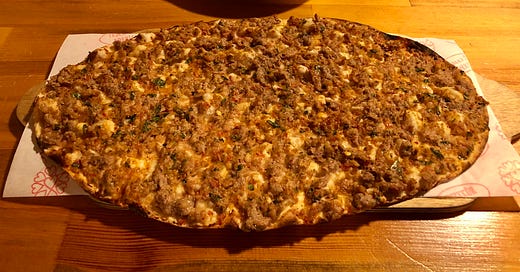



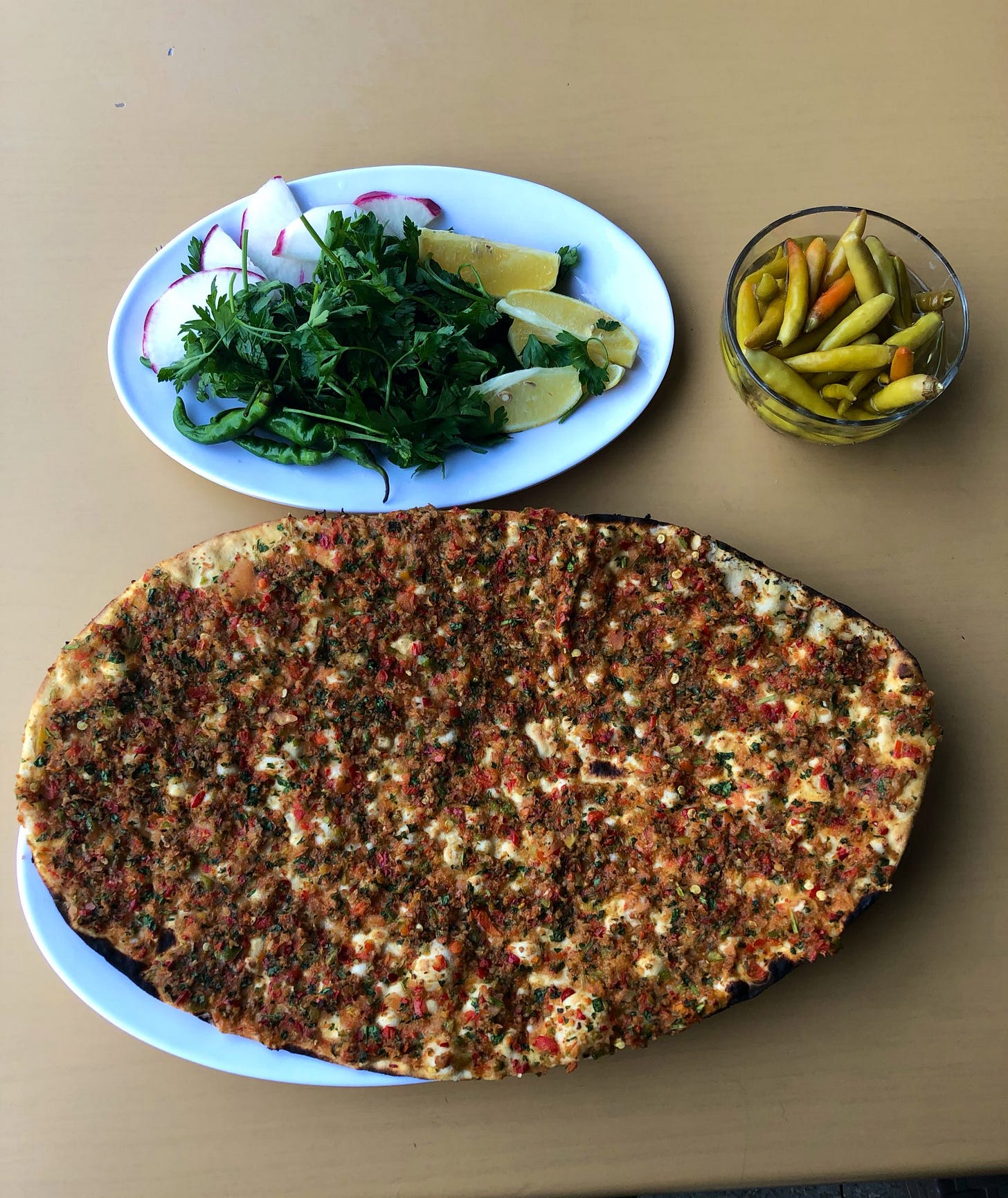
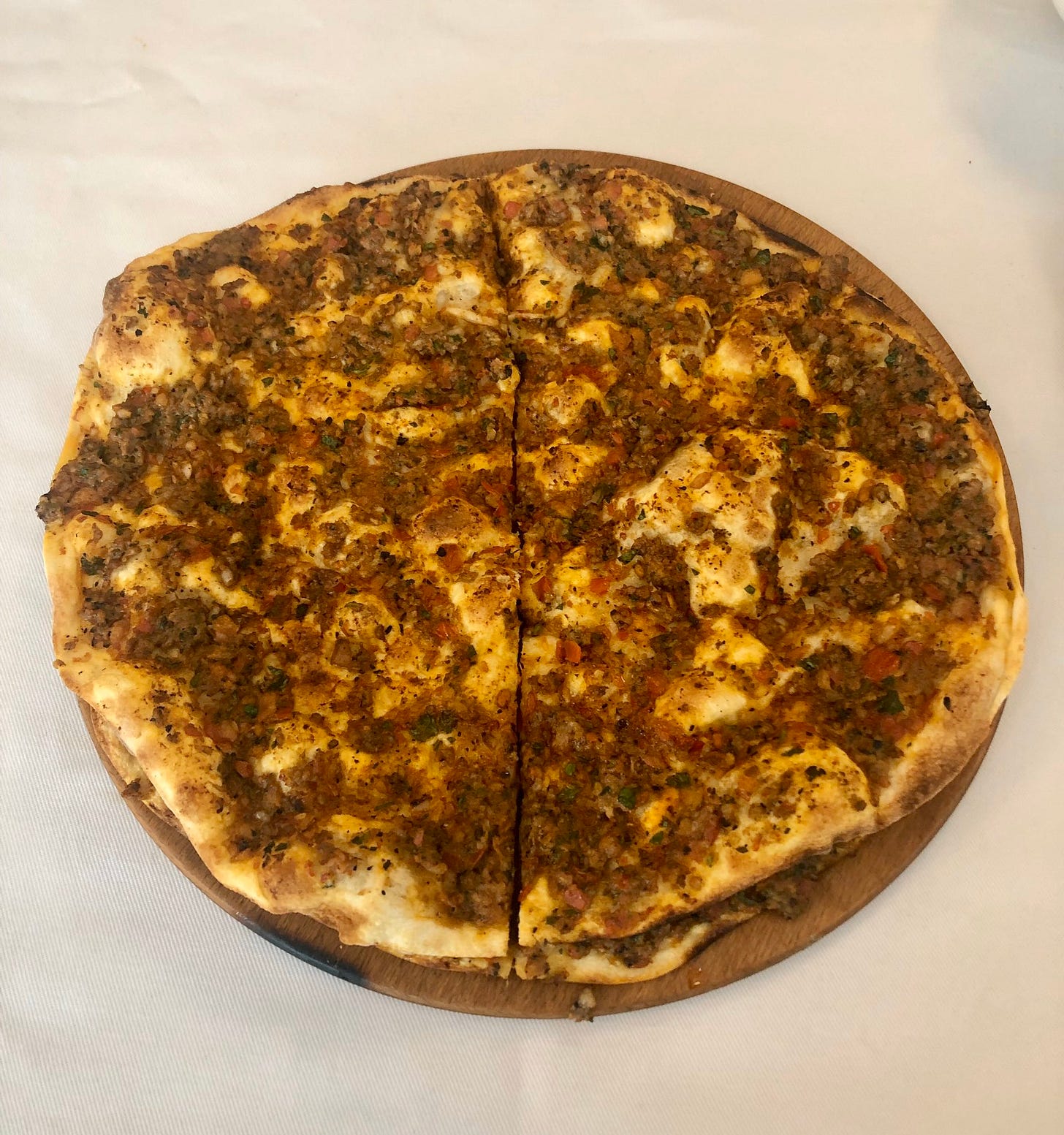
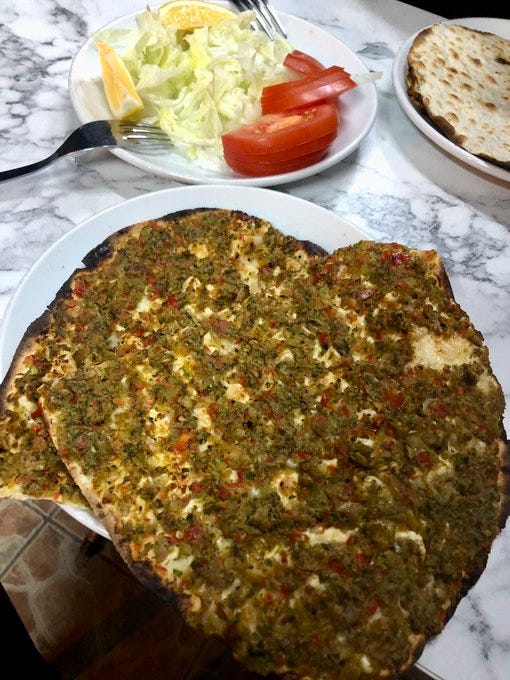
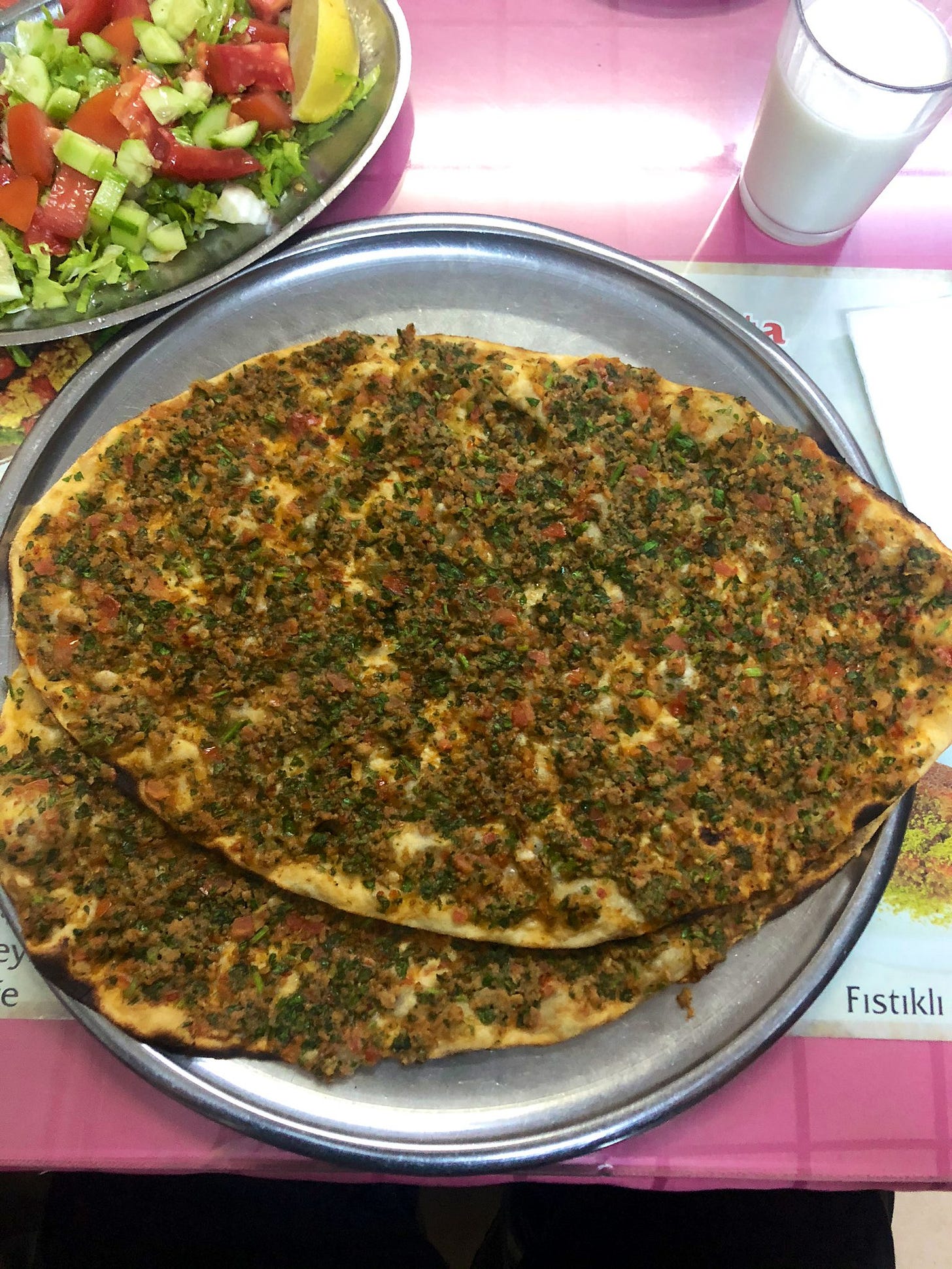
Must add to the Turkey list, Tabier in Diyarbekir. My favorite lahmacun ever
Excellent round-up. Had no idea regarding the differences between the Urfa/Gaziantep/Diyarbakır variations.
PS: Just wondering, any notes regarding the spicy lahmacuns' from Borsam Taşfırın@Kadıköy?